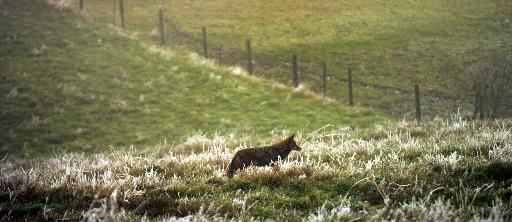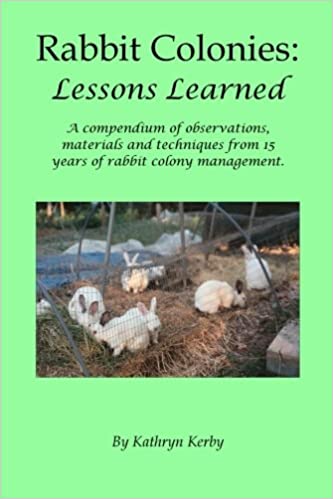|
Search this site for keywords or topics..... | ||

Custom Search
| ||
Chicken Coop
Predator Control

A lone coyote making his/her rounds in a pasture setting, looking for that next meal. Coyotes live in suburban areas and within major cities as well. They can prove to be frustratingly clever predators for flock owners. Other creatures such as skunk, raccoon, possum, and daytime or nighttime raptors can also hunt and kill unprotected poultry.
This topic is large, and could easily go well beyond the room we have available on just this one web page. And it's an important topic. If anything, this is the single biggest threat that many poultry owners will ever face. So what I write here is only a drop in the bucket for the collective knowledge which has been gathered and published to date. But I wanted to at least summarize what has been learned about what works, and what doesn’t.
What Doesn't Work
First, let's look at flock owner assumptions. Many flock owners, particularly new ones, will simply assume and hope and fervently believe that predators won’t find their small flock and take advantage of the situation. These owners will come up with rather elaborate reasons why their flock won’t be preyed upon – they’re in the city, they’re too small, the house/yard/surroundings are too busy, the area is well-lit, the dog in the house or yard will bark away intruders, etc. I’ll cut to the chase and say that none of those are sufficient to keep predators away.
Owls, skunks, raccoons and other mid-sized predators are all known to exist and thrive in even the most densely populated urban areas. These predators can and do pose constant threats to even the smallest flocks. Owners who don’t take precautions can lose their birds in a single night.
In the suburbs, the threats are even more pronounced. Larger predators such as coyotes can move more freely and without being noticed as much, and there are more of them. Neighborhood dogs will bark like crazy but won’t necessarily drive away predators who are accustomed to moving around and between fenced or chained dogs. Any relatively insecure building or open-sided shelter is an invitation to all manner of predators for a free chicken dinner, scrambled eggs, or both.
Rural residents need no introduction to predators, and would seem to be willing to at least put up some bare essentials to keep predators from their birds. Sadly, these owners are sometimes of the opinion that nothing can be done to discourage them or prevent losses. So they simply keep buying in replacement birds, and chalk up the losses as being inevitable.
Many people's first reaction once predators have made themselves known, is to try to trap and kill the one or two predators who happened to dine on the flock. This approach is also doomed to fail, for a few not-so-obvious reasons. First of all, let's say that yes there was only one predator in the area, and that predator has just been dispatched by some means and the neighborhood is safe once again. Really? Probably not. If one predator could get into the chicken coop or chicken yard and dine on fresh birds, any new predator that happens to stroll into the area will be able to do the same thing in the future. So the flock owner is faced with a choice - go through a lot of effort to trap and kill a whole parade of predators, one after the other, for the foreseeable future, or invest that same effort in fixing up the coop and yard such that predators can't get in to begin with. The former implies an ongoing problem and the same need for renewed effort every time. The latter is a one-time deal and then the flock owner can relax. Which approach sounds like the better deal? The flock owners who took the first approach are still dealing with predators, years later. The flock owners who took the second approach, don't even worry about predators anymore.
Secondly, this approach of kill-the-predator can actually create more problems than it solves. This is because the vast majority of predators are territorial in nature. So consider that a single predator is dining on a certain flock. There is a very good chance that particular predator is defending that area against other predators. If a flock owner kills that one predator, then all the other younger, less experienced, and now bolder predators will come into that same territory, looking for the meals that made that territory worth defending. Where a flock owner may have had one predator previously, this kill-the-predator approach will almost guarantee the flock owner will have half a dozen predators in the near future. This pattern has been particularly well documented with coyotes, where well-funded taxpayer-supported efforts to eradicate urban or suburban coyote populations has only served to increase those populations. Sorry to say, but this approach rarely ever provides a long-term solution.
What Does Work
Fortunately, a great deal can be done to protect the flock from predators. Keep in mind that predators are essentially on the clock – they are looking for the easiest meal and will give up Flock A if Flock B is easier to reach. The flock owner’s job, then, is to make their flock as hard to reach as possible.
First, a stout building and stout fencing can go a long, long way towards protecting the flock. One or the other is rarely sufficient, but both together can provide nearly total protection if well-designed. The fence needs to be tight, strong, and preferably include at least one hot-wire to discourage digging at the bottom. Two hot-wires, one at bottom and another at top to discourage jumping, is even better. That arrangement alone will discourage most terrestrial predators. A well-built chicken coop which features floors, walls and ceilings without gaps or breaks, and doors and windows that close securely, will protect blocks against the vast majority of both daytime and nighttime predators. The only type of predator which would not be discouraged by either measures, are daytime avian predators like eagles. If birds are being ranged on pasture or grass during the day, most of them will instinctively seek shelter as soon as they detect a shadow above them. Watching a flock move across a field, a person will start to notice that birds will regularly look up for exactly that type of shadow. And when such a shadow appears, they will run like crazy towards any surface they can hide under. Giving them adequate such shelters in a field setting is often all that is needed to protect against this last category of predator. It is only when one or more of these three systems fails – the roof, the building or the fence – that predation becomes a problem.
Second, clearing brush and trees away from the coop and/or poultry yard can also help discourage predators. Predators need to study a situation before making their move, and they rarely do so if they are themselves exposed. One of the most common situations is where brush is allowed to come right up to the poultry fence line, such that predators can hide out and study the situation all day long if they need to. Given that protection, they can usually figure out a way in. But if those predators had to cross a large open area just to be able to see the fencing, let alone the coop, they are much less likely to study it for very long. The big exception to this is in very rural areas where wide open expanses are unpopulated. Pastured flock owners have reported watching coyotes walk all around field pens, in broad daylight, searching for a way in. If no one but birds are in that field, those predators will have the luxury of time to study the situation and find a weakness. Which brings us to the third option.
Livestock guardian dogs and other guardian animals are not commonly considered for poultry protection, but they do work. Our own predator losses here dropped from a handful of losses per year with hot wire, down to one or two losses per year by clearing brush away from the fences, down to zero when we brought in livestock guardian dogs. As with predator control in general, a great deal has been written already about livestock guardian dogs, so I won't try to summarize it all here. Instead, I will say that livestock guardian dogs themselves need to be trained not to chase the birds, and as such they sometimes are not suitable for housing WITH the birds. However, they are very well suited to patrolling the areas immediately around the bird coops and yards. That is the arrangement we have used here, with excellent results. If dogs aren't an option for flock owners, other animals work too. Guardian donkeys and/or llamas can be used to keep moderate-sized predators out of a poultry yard. Even geese can be used for that purpose; they are particularly effective against avian predators who are exposed while on the ground with their fresh kills.
One additional option is to provide complete coverage for a flock, meaning a flight cage. This approach might sound clunky and expensive, but this is actually the approach used so successfully, in miniature, by chicken tractors. Each tractor is essentially a moving flight cage, giving birds some exercise space while being small enough to move to new locations every few days. Yet larger and completely protected runs which are not intended to move, can be built for relatively low cost. For urban and suburban settings, covered dog runs (available as kits), home-scale golf driving range nets, or baseball batting cages can all be used for flight cages with very good results. On a larger scale, the same netting used for batting cages and golf driving ranges, can be purchased by the square yard and used to build a custom aviary. Even bird netting can be used over a wooden or metal pole frame to provide a nice roomy exercise area. If a flock owner is really into alternative structures, a geodesic dome can be used to provide a very nice flight area as well. It all depends on how much room the flock owner wants to devote to the birds. Bottom line, even the smallest yard or even an urban balcony or deck can be fitted with a flight area or completely covered exercise area for a few birds.
Ongoing Research and
Additional Information
This topic of predator control is a constantly evolving field of intense interest. Everyone it seems wants a chicken dinner, so predators are constantly forcing us to come up with new ways to defend our birds. As we learn of new methods which work (or previously solid methods which prove to have flaws), we'll list them here as we become aware of them. If readers have any solutions they'd like to share, or stories about what worked and what didn't, let us know and we'll add that information to this page.
Poultry Books
Sponsored Products
Our Successful Farming and Ranching Books

We released our very first self-published book. The Chicken Coop Manual in 2014. It is a full color guide to conventional and alternative poultry housing options, including 8 conventional stud construction plans, 12 alternative housing methods, and almost 20 different design features. This book is available on Amazon.com and as a PDF download. Please visit The Chicken Coop Manual page for more information.

Rabbit Colonies: Lessons Learned
We started with rabbits in 2002, and we've been experimenting with colony management ever since. Fast forward to 2017, when I decided to write another book, this time about colony management. The book is chock-full of practical information, and is available from both Amazon and as a PDF download. Please visit the Rabbit Colonies page for more information.
The Pastured Pig Handbook
We are currently working on our next self-published book: The Pastured Pig Handbook. This particular book addresses a profitable, popular and successful hog management approach which sadly is not yet well documented. Our handbook, will cover all the various issues involved with pastured hog management, including case studies of numerous current pastured pig operations. If you have any questions about this book, please Contact Us.